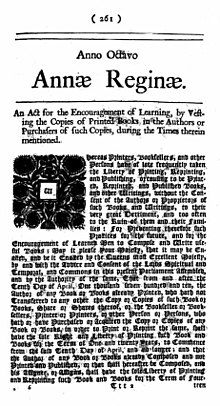Copyright Act de 1710
Le Copyright Act de 1710, également connu comme le Statute of Anne, du nom de la reine de l'époque, est une loi du Parlement qui est la première à permettre une régulation du copyright par le gouvernement et les tribunaux au lieu d'accords entre personnes privées. Cette loi permet à l'auteur d'obtenir le droit exclusif d'impression de son œuvre et introduit le premier élément de droit patrimonial sur les œuvres artistiques.

Avant cette loi, le Licensing Act de 1662 permettait des restrictions au droit de copie et seule une corporation (appelée Stationers' Company) avait le droit d'imprimer en Grande-Bretagne et la responsabilité de censurer les écrits.
En 1694, le Parlement refuse de renouveler le Licensing Act mettant ainsi fin au monopole de la Stationers' Company. Après 10 ans de négociations la Stationers' Company propose un système de licence par auteur et non plus par imprimeur, idée qui cette fois sera considérée favorablement par le Parlement et aboutira au Statute of Anne.
Cette loi fixe une durée de droit d'auteur de 14 ans — avec une seule possibilité de renouvellement — pour les ouvrages nouvellement édités ; à l'issue de cette période l’œuvre entre dans le domaine public. Le Statute of Anne fut rédigé en 1709 et appliqué du jusqu'au Copyright Act de 1842. Cette loi a influencé la réglementation du copyright dans plusieurs autres nations dont les États-Unis et fait l'objet d'une bibliographie abondante.
Notes et références
modifierVoir aussi
modifierBibliographie
modifier- (en) Abrams, Howard B. (1985). "The Historical Foundation of American Copyright Law: Exploding the Myth of Common Law Copyright". Wayne Law Review. Wayne State University Law School. 29 (3). (ISSN 0043-1621).
- (en) Alexander, Isabella (2010). Copyright Law and the Public Interest in the Nineteenth Century. Hart Publishing. (ISBN 978-1-84113-786-5).
- (en) Bently, Lionel (2010). The History of Copyright. Global Copyright: 300 Years Since the Statute of Anne, from 1709 to Cyberspace. Edward Elgar. (ISBN 978-1-84980-831-6).
- (en) Bracha, Oren (2010). "The Adventures of the Statute of Anne in the Land of Unlimited Possibilities: The Life of a Legal Transplant". Berkeley Technology Law Journal. UC Berkeley School of Law. 25 (1). (ISSN 1086-3818).
- (en) Cornish, William (2010). The Statute of Anne 1709–10: Its Historical Setting. Global Copyright: 300 Years Since the Statute of Anne, from 1709 to Cyberspace. Edward Elgar. (ISBN 978-1-84980-831-6).
- (en) Deazley, Ronan (2003). "The Myth of Copyright at Common Law". Cambridge Law Journal. Cambridge University Press. 62 (1). (ISSN 0008-1973).
- (en) Deazley, Ronan (2004). On the Origin of the Right to Copy. Hart Publishing. (ISBN 978-1-84113-375-1).
- (en) Deazley, Ronan (2006). Rethinking Copyright: History, Theory, Language. Edward Elgar Publishing. (ISBN 978-1-84720-944-3).
- (en) Deazley, Ronan (2010). "The Statute of Anne and the Great Abridgement Swindle". Houston Law Review. University of Houston Law Center. 47 (4). (ISSN 0018-6694).
- (en) Deene, Joris (2010). The Influence of the Statute of Anne on Belgian copyright law. Global Copyright: 300 Years Since the Statute of Anne, from 1709 to Cyberspace. Edward Elgar. (ISBN 978-1-84980-831-6).
- (en) Geiger, Christophe (2010). The Influence (Past and Present) of the Statute of Anne in France. Global Copyright: 300 Years Since the Statute of Anne, from 1709 to Cyberspace. Edward Elgar. (ISBN 978-1-84980-831-6).
- (en) Hauhart, Robert C. (1983). "The Origin and Development of the British and American Patent and Copyright Laws". Whittier Law Review. Whittier Law School. 5 (1). (ISSN 0195-7643).
- (en) Henn, Harry G., "Magazine Rights" - A division of indivisible copyright contenu dans Copyright and Related Topics : A Choice of Articles, Los Angeles, University of California Press, (présentation en ligne)
- (en) Holdsworth, William (1920). "Press Control and Copyright in the 16th and 17th Centuries". Yale Law Journal. Yale Law School. 29 (1). (ISSN 0044-0094).
- (en) Patterson, L. Ray; Joyce, Craig (2003). "Copyright in 1791: An Essay Concerning the Founders' View of Copyright Power Granted to Congress in Article 1. Section 8, Clause 8 of the U.S. Constitution". Emory Law Journal. Emory University School of Law. 52 (1). (ISSN 0094-4076).
- (en) Patterson, L. Ray (1965). "The Statute of Anne: Copyright Misconstrued". Harvard Journal on Legislation. Harvard Law School. 3 (1). (ISSN 0017-808X).
- (en) Robinson, A.J.K (1991). "The Evolution of Copyright, 1476–1776". Cambrian Law Review. University of Wales Press. 22 (1). (ISSN 0084-8328).
- (en) Rose, Mark (2009). "The Public Sphere and the Emergence of Copyright: Areopagitica, the Stationers' Company and the Statute of Anne". Tulane Journal of Technology and Intellectual Property. Tulane University Law School. 12 (1). (ISSN 1533-3531).
- (en) Rose, Mark (2003). "Nine-Tenths of the Law: The English Copyright Debates and the Rhetoric of the Public Domain". Law and Contemporary Problems. Duke University School of Law. 66 (Spring). (ISSN 0023-9186).
- (en) Rose, Mark (1993). Authors and owners: the invention of copyright. Harvard University Press. (ISBN 978-0-674-05309-0).
- (en) Seville, Catherine (2011). Literary Copyright Reform in Early Victorian England: The Framing of the 1842 Copyright Act. Cambridge University Press. (ISBN 9780521174503).
- (en) Seville, Catherine (2010). "The Statute of Anne: Rhetoric and Reception in the Nineteenth Century". Houston Law Review. University of Houston Law Center. 47 (4). (ISSN 0018-6694).
- (en) Streibich, Harold C. (1976). "The Moral Right of Ownership to Intellectual Property: Part II From the Age of Printing to the Future". University of Memphis Law Review. Cecil C. Humphreys School of Law. 7 (1). (ISSN 1080-8582).
Articles connexes
modifier- Histoire du droit d'auteur
- Engraving Copyright Act de 1735 sur les droits d'auteur des graveurs au Royaume-Uni
Liens externes
modifier
- Notice dans un dictionnaire ou une encyclopédie généraliste :
- (en) The Statute of Anne: The First Copyright Statute (1709)
- (en) Scan du document original sous licence Creative Commons